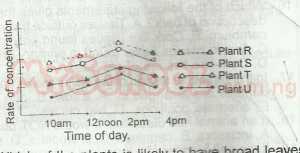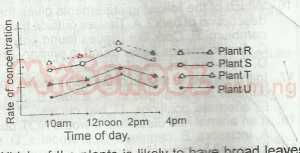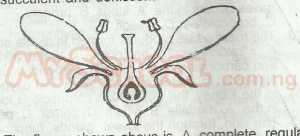Year :
1987
Title :
Biology
Exam :
JAMB Exam
Paper 1 | Objectives
41 - 50 of 50 Questions
| # | Question | Ans |
|---|---|---|
| 41. |
In which of the following crosses will all the female offspring be colour blind? A. colour blind mother x colour blind father B. colour blind mother x normal father C. carrier mother x colour blind father D. carrier mother x normal father |
A |
| 42. |
Which of the following relates to edaphic factors? A. The structure of the earth's surface B. The influence of living organisms on each other C. Temperature, rainfall and humidity D. The influence of soils on plant and animals |
D |
| 43. |
Epiphytes growing on the branches of trees provide an example of the relationship known as A. parasitism B. commensalism C. saprophytism D. holophytism |
B |
| 44. |
Poliomyelitis is an infectious diseases caused by A. virus B. protozoan C. bacterium D. fungus |
A |
| 45. |
One of the functions of UNICEF is to A. prevent and control major disease B. prevent diseases outbreak by administering vaccines C. improve the health and nutrition of children and nursing mothers D. monitir enviromental pollution |
C |
| 46. |
Nitrifying bacteria are important because they A. release nitrogen to the atmosphere B. convert atmospheric nitrogen to ammonia C. combine ammonia with nitrgen D. oxidize ammmonium salt to nitrates |
D |
| 47. |
The process by which lime is added to clay soil is known as A. sedimentation B. flocculation C. leaching D. manuring |
B |
| 48. |
 Which of the plants is likely to have broad leaves and thin cuticle A. R B. S C. T D. U |
A |
| 49. |
 Which of the plants is likely to be desert species? A. U B. T C. S D. R Detailed SolutionNotice the rate of concentration for Plant U was steadily increased with increasing sunlight, and started dropping once the sun started going down. Hence, it would be easier for U to survive easily in the desert. |
|
| 50. |
 The flower shown above is A. complete, regular, hermaphroditic with superior ovary B. incomplete, regular, staminate with inferior ovary C. complete, regular, hermaphroditic with inferior ovary D. incomplete, irregular, pistillate with superior ovary |
C |
| 41. |
In which of the following crosses will all the female offspring be colour blind? A. colour blind mother x colour blind father B. colour blind mother x normal father C. carrier mother x colour blind father D. carrier mother x normal father |
A |
| 42. |
Which of the following relates to edaphic factors? A. The structure of the earth's surface B. The influence of living organisms on each other C. Temperature, rainfall and humidity D. The influence of soils on plant and animals |
D |
| 43. |
Epiphytes growing on the branches of trees provide an example of the relationship known as A. parasitism B. commensalism C. saprophytism D. holophytism |
B |
| 44. |
Poliomyelitis is an infectious diseases caused by A. virus B. protozoan C. bacterium D. fungus |
A |
| 45. |
One of the functions of UNICEF is to A. prevent and control major disease B. prevent diseases outbreak by administering vaccines C. improve the health and nutrition of children and nursing mothers D. monitir enviromental pollution |
C |
| 46. |
Nitrifying bacteria are important because they A. release nitrogen to the atmosphere B. convert atmospheric nitrogen to ammonia C. combine ammonia with nitrgen D. oxidize ammmonium salt to nitrates |
D |
| 47. |
The process by which lime is added to clay soil is known as A. sedimentation B. flocculation C. leaching D. manuring |
B |
| 48. |
 Which of the plants is likely to have broad leaves and thin cuticle A. R B. S C. T D. U |
A |
| 49. |
 Which of the plants is likely to be desert species? A. U B. T C. S D. R Detailed SolutionNotice the rate of concentration for Plant U was steadily increased with increasing sunlight, and started dropping once the sun started going down. Hence, it would be easier for U to survive easily in the desert. |
|
| 50. |
 The flower shown above is A. complete, regular, hermaphroditic with superior ovary B. incomplete, regular, staminate with inferior ovary C. complete, regular, hermaphroditic with inferior ovary D. incomplete, irregular, pistillate with superior ovary |
C |